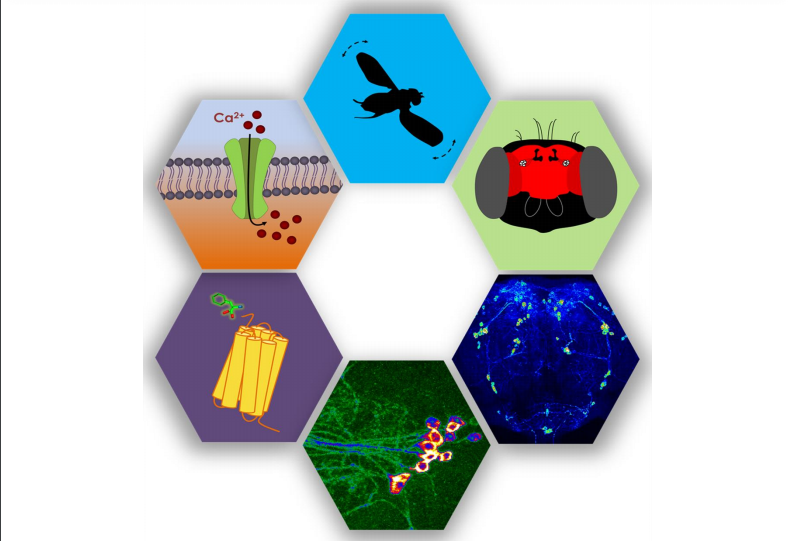Have you ever wondered how tirelessly the tiny fruit fly buzzes around your fruit bowl? This behavior not only demands tremendous energy but also requires highly coordinated neuronal signaling that enables continuous flight. A recent study from Prof. Gaiti Hasan’s lab has uncovered molecules required in the fruit flies brain that enables flight for long periods of time and helps them locate the fruit bowl in your pantry. One of the key proteins identified in this study is the FMRFa receptor (FMRFaR). The authors describe a role for this receptor in a specific class of neurons in the adult fly brain which helps the fly sustain flight for long periods of time. The study was published in PLOS Genetics Journal with lead author, Preethi Ravi's striking making it to the cover page as well!
The FMRFaR belongs to a class of proteins known as G-protein coupled receptors (GPCRs). GPCRs are well-studied molecules that help convert extracellular messages such as hormones or neurotransmitters into cellular responses. Under laboratory conditions, while wild-type flies were able to maintain flight for an average of over 10 minutes, FMRFaR mutant flies could sustain flight for only half that time. Using genetic experiments, the authors were able to narrow down the function of this receptor to a specific class of neurons in the fly’s brain, namely neurons that make and use the neurotransmitter dopamine for communication with other neurons. Dopamine has been implicated in both fly and mammalian behaviors such as locomotion, motivation, addiction, learning, and memory.
“The reason I decided to pursue FMRFaR amongst various others receptors, was the observation that loss of FMRFaR signaling specifically in adult dopaminergic neurons of the fruit fly resulted in severe flight loss. This was the first time that we had encountered a GPCR that was required in the central brain of adult flies for flight and that’s what made it really exciting”, says Preethi.
In the current study, the authors show that changes in cellular calcium brought about by activation of the FMRFaR regulate flight and are required to maintain excitability of mature dopaminergic neurons of the fly brain. Neuronal excitability is one key process that allows neurons to communicate with each other and ultimately results in motor behavior.
The question then is: how does FMRFaR regulate neuronal excitability in these neurons? Activation of the FMRFaR triggers the release of calcium from the endoplasmic reticulum (ER) into the cytosol of the cell through another intracellular receptor plus calcium channel called the Inositol-trisphosphate receptor (IP3R). The calcium released through such a trigger activates other calcium-sensitive proteins in the neuron. In this study, the authors have identified a Calcium-calmodulin Protein Kinase (CaMKII) as a downstream effector of FMRFaR activation. The authors speculate that FMRFaR stimulated calcium activates CaMKII, which could either directly or indirectly activate channels that determine the excitability of the neuronal plasma membrane.
“One would expect that flying for several minutes at a stretch would require a continuous stream of sensory information for the fly to reach its destination. Here, we believe that the FMRFaR on dopaminergic neurons helps in processing such sensory information and thus enables sustained flight in the right direction”, says corresponding author, Prof. Hasan.
Which plasma membrane channels are activated by FMRFaR signaling? What is the underlying mechanism of their activation? Where does the signal for triggering FMRFaR activation come from? The hunt for answers to these questions is now keeping the team busy.










0 Comments